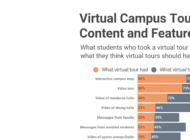Building an Effective Online Walking Tour
The guide pauses, extending her arm to indicate an ivy-covered building and describes a campus tradition while the tour group takes in the scene. Parents follow along posing questions, while prospective students glance nervously at their potential future classmates and try to imagine themselves just one year from now, stepping out on their own for the first time. The college campus walking tour, a rite-of-passage for students, has become such a central component of the college search process that many colleges have now moved their walking tours online.
The Online Walking Tour
From the moment when college Web sites first emerged in the early 1990s, the campus tour has been a widely adopted .edu Web site fixture. In conceiving these first online tours, colleges naturally adopted the stop-based walking tour model as the best way to deliver an “equivalent experience” to the tours provided for on-campus visitors. Virtual walking tours have evolved from using still photographs to panoramic images to video guides and even Virtual Reality scenes, and while there are a wide variety of tour approaches used today, a good portion of the virtual tours on college sites are still organized in the familiar stop-based walking tour paradigm.
The familiarity of the concept of the campus walking tour derives from the fact that colleges, faced with the challenge of convincing students to apply to their institutions, have concocted these informal excursions as the best way of showcasing the complex community of a modern college or university. The traditional walking tour, in which parents and their children schlep from building to building while the tour guide delivers a running monologue of institutional features, purports to provide an overview from which students can usefully differentiate between schools. Using the buildings and facilities as emblems of the exciting activities occurring within their walls, tour guides describe the campus life through the lens of locations.
Moving the campus walking tour online is often achieved by simply choosing a route similar to the actual campus tour and creating online tour stops that mirror the stops on the on-campus tour. The story of the institution is delivered gradually as the tour guide describes the use and purpose of each building.
The weakness of the online walking tour is that as the concept has become ubiquitous and each college has developed their own walking tour, the experience has become increasingly mundane and repetitive for the prospective student. Furthermore, since most prospective students will not yet have visited the campus(es), the tour stops (which are often named after the buildings) are a confusing and non-intuitive way to explore information pertinent to them. Ironically, the practice of organizing the tour into a series of stops based on traveling between buildings is a much less effective storytelling mechanism when the visitor is virtual.
Improving the Online Walking Tour
The online walking tour has an opportunity to take core elements from the traditional on-campus walking tour, and extend them in ways that are impossible during in-person scheduled tours.
- Instead of simply recreating the route of your on-campus walking tour, you may also want to organize stops around traditional campus topics like campus life, athletics, academic programs, social life, extracurricular activities, study abroad etc. This allows prospective students to learn about your buildings as they learn about your culture, instead of the other way around.
- Online walking tours differ substantially from in-person walking tours, and one of the most critical differences is in the inability of online tours to allow meaningful participation or questions from participants. This makes the tour more like a canned video experience, and leads to students clicking rapidly through the tour in search of information that is pertinent to them. CampusTours recommends adding Student Commentary and other integrated video to increase the “depth” of tour stops and allow for more informal investigation by visitors.
- One of the reasons that in-person tours are so popular is that in walking around a campus, visitors are able to get a sense for the culture and community that pervades the institution – is it a serious place where people rush between classes and the library, or a relaxed atmosphere where fraternity parties are the norm? Virtual tours tend to suppress these natural cultural distinctions with bland guide videos that promise all things to all people. CampusTours recommends including more about your campus culture, and allowing students to speak informally through tools like Student Commentary to help prospective students understand the character of the institution.
- Technology can help you tell your story, but be sure the technology is supporting your message, and is not simply there for the “gee-whiz” effect. Students almost never make a decision about a school because of its architecture. No one ever says “I came here because I liked how the buildings looked.” So spending a lot of time showcasing your buildings in panoramic images, videos or Virtual Reality scenes risks missing the point – it’s what goes on inside the buildings that you want to showcase.
- Online walking tours have a tremendous opportunity to improve on the traditional walking tour, by adding in tours for specific academic departments, creating the opportunity for prospective students to listen to video commentaries from current students, and adding granular content that is too specific to be included in actual campus visits. Because the online walking tour is always available, over time colleges can refine their tour experiences to include a magnitude of content that would be impossible to deliver during an in-person walking tour.




